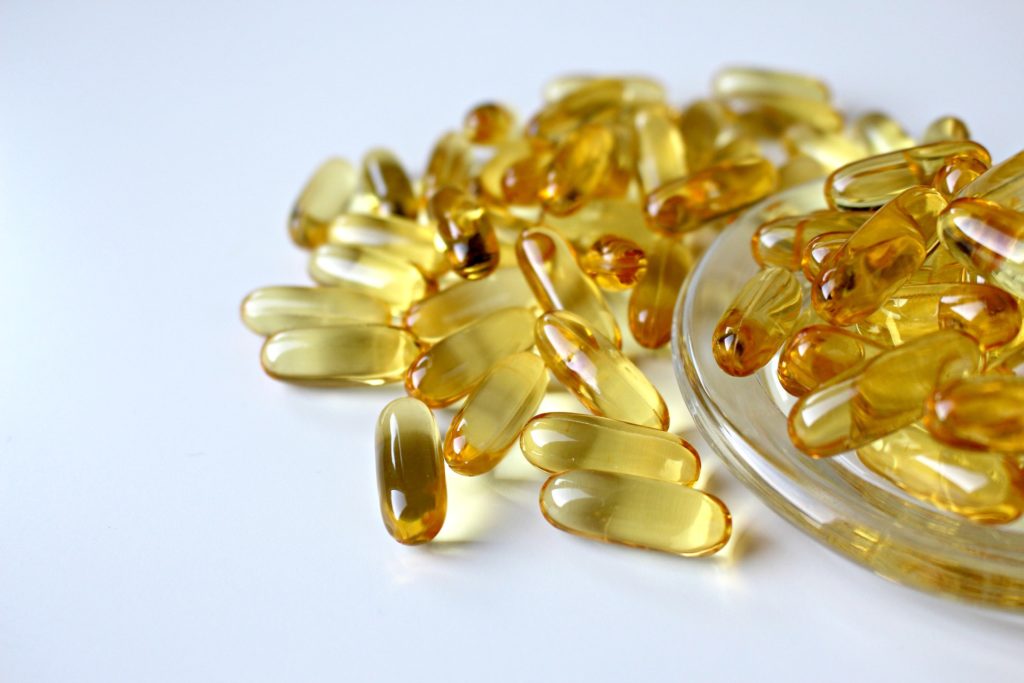Author- Marina McDonald, MS, PhD. March 31, 2020, Allergy Research Group
Are you familiar with DHA, also known as docosahexaenoic acid (pronounced doh-koh-sah-hex-ah-een-oh-ick acid)? DHA is the longest-chain omega-3 fatty acid, found in fish oil and in the diet in general.
Along with its omega-3 companion, eicosapentaenoic acid (EPA), DHA is essential for health at all ages, which is why they are also commonly referred to as essential fatty acids.[1],[2] Studies have shown that higher intakes of DHA and EPA are associated with a reduced risk of chronic diseases, including Alzheimer’s disease, age-related eye diseases, heart disease, stroke, joint pain, chronic fatigue, and total mortality.[3],[4],[5],[6],[7],[8]
Most organs in the body contain both EPA and DHA, but the brain and retina (the layer of tissue at the back of the eyeball) are unique in having very high levels of DHA and virtually no EPA.[9] In fact, DHA comprises nearly half of the polyunsaturated fatty acids (PUFAs) in the brain.[9],[10] It’s not surprising that a continuous supply of DHA is needed to keep our brains working throughout the lifespan.[11],[12],[13],[14]
Only small amounts of DHA can be made in the body from precursors such as ALA (alpha-linolenic acid, found in plant oils),[15] and it’s difficult to consume adequate amounts of DHA from the diet because it is found in so few food sources. The main way to obtain DHA is to consume seafood and/or omega-3 supplements, particularly formulations that are enriched in DHA. Let’s look at why DHA is so important, with a focus on the brain and eyes.
DHA and Alzheimer’s disease
Low levels of DHA are associated with cognitive decline, even in young adults. In a study of young women with an average age of 27 years, cognitive function (specifically attention) was poorer in those with lower DHA blood levels.[16] This reduced but normal level of cognition potentially provides a lower baseline from which cognition would continue to decline with age.
Individuals with Alzheimer’s disease (AD) have significantly less DHA in their blood and brain than those without AD.[17],[18] They also have lower levels of neuroprotectin D1 (NPD1),[19] a bioactive substance derived from DHA that keeps brain cells happy and healthy.[20],[21],[22]
Individuals who consume diets containing high levels of omega-3 fatty acids have a reduced risk of AD and other neurodegenerative conditions.[2] AD is characterized by an accumulation of beta-amyloid, a peptide that triggers the disease process.[23],[24] Studies suggest that both DHA and NPD1 inhibit beta-amyloid accumulation via multiple mechanisms.[22],[25],[26],[27]
The accumulation of beta-amyloid can begin decades before the clinical symptoms of AD become apparent,[28] so it is important to consume enough omega-3s throughout life.[16],[29],[30],[31] In one remarkable study, healthy postmenopausal women were first assessed for omega-3 levels in the blood, and then they were followed up with a brain MRI eight years later.[32] The researchers found that higher initial blood levels of DHA and EPA were associated with larger brain volumes after eight years, suggesting that DHA and EPA may protect against brain atrophy. The changes were especially pronounced in the hippocampus, a region associated with long-term memory.
In a placebo-controlled clinical trial, which directly tested the effects of DHA supplementation in adults age 55 and older with age-related cognitive decline, supplementation with 900 mg of DHA per day for six months doubled the plasma DHA levels and significantly improved memory and learning scores.[33]
Because brain lipids turn over slowly, it can take months of DHA supplementation to increase the brain levels of DHA.[34] In a study of patients with AD, supplementation with 2.3 grams of DHA daily produced a small but significant increase in the DHA levels in cerebrospinal fluid after six months.[35] However, it’s difficult to alter the course of AD once neurodegeneration has occurred.
Individuals with a genetic predisposition to AD may have difficulty transporting DHA into the brain, and are thus more resistant to DHA supplementation at any age.[36] The main culprit is a cholesterol carrier gene known as APOE4 (apolipoprotein E4), which is present in approximately 25% of the population.[37],[38],[39] Testing for APOE4 is not routine, so most of us do not know if we are carrying this gene (unless there is a family history of AD, which can be a clue).[40] DHA supplementation may help slow the progression of AD in APOE4 carriers, but only if supplementation begins at a very early stage.[30],[41]
Because inadequate levels of DHA and/or vitamins B and/or D are associated with cognitive decline,[42],[43] it makes sense that supplementation with multiple nutrients may be more effective than DHA alone.[44],[45] This concept was validated in a clinical trial in individuals with mild cognitive impairment, who had insufficient B vitamins as indicated by elevated blood homocysteine levels.[46] B vitamin supplementation helped slow the rate of cognitive decline, but only when DHA levels were in the upper normal range. DHA may also synergize with nutritional antioxidants such as astaxanthin. In an animal model of AD, the combination of DHA and astaxanthin helped slow the disease progression to a greater extent than astaxanthin alone.[47]
DHA and attention deficit hyperactivity disorder
Just as it sounds, the condition known as attention deficit hyperactivity disorder (ADHD) is characterized by difficulty concentrating, hyperactivity, and impulsive behavior. It affects 2 to 5% of the general population and is more prevalent in boys than girls.[48],[49] Although ADHD generally starts in childhood, it often continues into adulthood.
Children with ADHD were found to consume significantly less EPA and DHA on average,[50] and to have lower blood levels compared to their peers without ADHD.[49],[51],[52],[53] Moreover, children with lower blood EPA and DHA levels had more severe behavioral symptoms than those with higher levels.[54],[55],[56]
An intriguing study suggests that an insufficient supply of omega-3s during adolescence may hinder the development of impulse control, an aspect of ADHD.[57] Impulse control is required to control risky behaviors, and it develops during adolescence as the prefrontal cortex (PFC) of the brain matures. In 87 adolescent boys and girls enrolled in a brain imaging study, omega-3 intake was correlated not only with ADHD behavior, but also with localized PFC brain activity during a standardized test of impulse control.[57]
Clinical trials suggest that DHA supplementation can be beneficial for individuals with ADHD.[13],[58],[59],[60] In one placebo-controlled trial, 66 children with ADHD (between 6 and 18 years of age) were supplemented with 1,000 mg of DHA per day.[61] Improvements in behavioral measures were seen in the supplemented group compared to the placebo group after three months. This study provides further evidence of the benefits of DHA for the management of ADHD.
DHA and eye health
DHA is the most abundant polyunsaturated fatty acid (PUFA) in the retina, representing more than half of the total fatty acids.[62] Similar to the brain, the DHA-derived neuroprotective substance known as NPD1 helps support retinal health.[63],[64],[65],[66]
Several studies show that low blood DHA levels may increase the risk of age-related macular degeneration and that DHA may reduce this risk, as long as supplementation begins at an early stage of the disease.[67],[68],[69] In addition, DHA supplementation may improve dry eye disease,[70] diabetic retinopathy,[71] and some forms of glaucoma.[72]
Published case studies also suggest that dietary supplementation with DHA may improve reading ability in children with dyslexia.[73],[74] One theory is that the difficulty in reading experienced by children with dyslexia may be caused by abnormal development of their visual magnocellular (M) nerve cells, which mediate the ability to rapidly identify letters and their order.[75] M cell membranes require DHA to maintain their rapid responses, which would explain why DHA may be beneficial.[75]
As a nutraceutical for the eyes, DHA may be used alongside antioxidant or multivitamin formulations that provide lutein and zeaxanthin.[76],[77] Supplementation with highly concentrated DHA plus a multivitamin/mineral supplement containing lutein and zeaxanthin was associated with a progressive and significant improvement of macular function in individuals with diabetic retinopathy.[71] The DHA dosage was 1050 mg daily for 90 days.
How much DHA do we need?
The American Heart Association recommends consuming 3.5 ounces of fish at least twice per week, which would provide an average of about 500 mg of combined EPA and DHA per day.[78] (For children, the recommendation is for one to two servings of fish per week.)[79] Fewer than one in ten individuals in the population actually achieve this recommended level of fish intake.[80] Unless we take omega-3 supplements, many of us may thus have inadequate intakes.
Concerns related to the contamination of fish with heavy metals and organic pollutants also means that, despite the benefits of omega-3s in fish, we may not want to consume excessive quantities of wild fish.[81] Of further concern, a recent publication reports that the EPA and DHA content of farmed salmon has halved due to altered fish production and feeding methods,[82] meaning that average intakes of these nutrients are probably lower than ever before.[83]
Many standard fish oil supplements have more EPA than DHA, but newer supplements containing highly concentrated DHA are available. Such DHA-enriched supplements are often made with a process known as molecular distillation, which allows the preparation of highly concentrated and purified DHA.[1],[84]
Regarding dosage, studies correlating DHA levels in blood lipids with health statistics suggest that more than 1 gram of DHA daily, from food and/or supplements, may be required.[11],[35],[85],[86] The intake of up to 3 grams of omega-3s per day is generally recognized as safe.[13]
In short, to take care of your brain and eyes throughout life, reach for some pure DHA !
[1] Ghasemi Fard S, et al. How does high DHA fish oil affect health? A systematic review of evidence. Crit Rev Food Sci Nutr. 2019;59(11):1684-1727.
[2] Avallone R, et al. Omega-3 fatty acids and neurodegenerative diseases: new evidence in clinical trials. Int J Mol Sci. 2019 Aug 30;20(17):4256.
[3] Kris-Etherton PM, et al. Recent clinical trials shed new light on the cardiovascular benefits of omega-3 fatty acids. Methodist Debakey Cardiovasc J. 2019 Jul-Sep;15(3):171-8.
[4] Saber H, et al. Omega-3 fatty acids and incident ischemic stroke and its atherothrombotic and cardioembolic subtypes in 3 US cohorts. Stroke. 2017 Oct;48(10):2678-85.
[5] NaPier Z, et al. Omega-3 fatty acid supplementation reduces intervertebral disc degeneration. Med Sci Monit. 2019 Dec 14;25:9531-7.
[6] Castro-Marrero J, et al. Low omega-3 index and polyunsaturated fatty acid status in patients with chronic fatigue syndrome/myalgic encephalomyelitis. Prostaglandins Leukot Essent Fatty Acids. 2018 Dec;139:20-4.
[7] Wang H, et al. The role of fish oil in inflammatory eye diseases. Biomed Hub. 2017 Feb 21;2(1):1-12.
[8] Mozaffarian D, et al. Plasma phospholipid long-chain ω-3 fatty acids and total and cause-specific mortality in older adults: a cohort study. Ann Intern Med. 2013 Apr 2;158(7):515-25.
[9] Chen CT, et al. The low levels of eicosapentaenoic acid in rat brain phospholipids are maintained via multiple redundant mechanisms. J Lipid Res. 2013 Sep;54(9):2410-22.
[10] Querques G, et al. Retina and omega-3. J Nutr Metab. 2011;2011:748361.
[11] Weiser MJ, et al. Docosahexaenoic acid and cognition throughout the lifespan. Nutrients. 2016 Feb 17;8(2):99.
[12] Echeverría F, et al. Docosahexaenoic acid (DHA), a fundamental fatty acid for the brain: new dietary sources. Prostaglandins Leukot Essent Fatty Acids. 2017 Sep;124:1-10.
[13] Reimers A, Ljung H. The emerging role of omega-3 fatty acids as a therapeutic option in neuropsychiatric disorders. Ther Adv Psychopharmacol. 2019 Jun 24;9:2045125319858901.
[14] Hashimoto M, et al. Docosahexaenoic acid: one molecule diverse functions. Crit Rev Biotechnol. 2017 Aug;37(5):579-97.
[15] Plourde M, Cunnane SC. Extremely limited synthesis of long chain polyunsaturates in adults: implications for their dietary essentiality and use as supplements. Appl Physiol Nutr Metab. 2007 Aug;32(4):619-34.
[16] Cook RL, et al. Omega-3 polyunsaturated fatty acids status and cognitive function in young women. Lipids Health Dis. 2019 Nov 6;18(1):194.
[17] Ammann EM, et al. Erythrocyte omega-3 fatty acids are inversely associated with incident dementia: secondary analyses of longitudinal data from the Women’s Health Initiative Memory Study (WHIMS). Prostaglandins Leukot Essent Fatty Acids. 2017 Jun;121:68-75.
[18] deWilde MC, et al. Lower brain and blood nutrient status in Alzheimer’s disease: Results from meta-analyses. Alzheimers Dement (N Y). 2017 Jun 24;3(3):416-31.
[19] Asatryan A, Bazan NG. Molecular mechanisms of signaling via the docosanoid neuroprotectin D1 for cellular homeostasis and neuroprotection. J Biol Chem. 2017 Jul 28;292(30):12390-7.
[20] Stark DT, Bazan NG. Neuroprotectin D1 induces neuronal survival and downregulation of amyloidogenic processing in Alzheimer’s disease cellular models. Mol Neurobiol. 2011 Apr;43(2):131-8.
[21] Zhao Y, et al. Docosahexaenoic acid-derived neuroprotectin D1 induces neuronal survival via secretase- and PPARγ-mediated mechanisms in Alzheimer’s disease models. PLoS One. 2011 Jan 5;6(1):e15816.
[22] Lukiw WJ, et al. A role for docosahexaenoic acid-derived neuroprotectin D1 in neural cell survival and Alzheimer disease. J Clin Invest. 2005 Oct;115(10):2774-83.
[23] Murphy MP, LeVine H 3rd. Alzheimer’s disease and the amyloid-beta peptide. J Alzheimers Dis. 2010;19(1):311-23.
[24] Cai Z, et al. Microglia, neuroinflammation, and beta-amyloid protein in Alzheimer’s disease. Int J Neurosci. 2014 May;124(5):307-21.
[25] Lee BY, et al. Effect of varying concentrations of docosahexaenoic acid on amyloid beta (1⁻42) aggregation: an atomic force microscopy study. Molecules. 2018 Nov 27;23(12):3089.
[26] Teng E, et al. Dietary DHA supplementation in an APP/PS1 transgenic rat model of AD reduces behavioral and Aβ pathology and modulates Aβ oligomerization. Neurobiol Dis. 2015 Oct;82:552-60.
[27] Grimm MO, et al. Docosahexaenoic acid reduces amyloid beta production via multiple pleiotropic mechanisms. J Biol Chem. 2011 Apr 22;286(16):14028-39.
[28] Külzow N, et al. Impact of omega-3 fatty acid supplementation on memory functions in healthy older adults. J Alzheimers Dis. 2016;51(3):713-25.
[29] Cederholm T, et al. ω-3 fatty acids in the prevention of cognitive decline in humans. Adv Nutr. 2013 Nov 6;4(6):672-6.
[30] Yassine HN, et al. Association of docosahexaenoic acid supplementation with Alzheimer disease stage in apolipoprotein e ε4 carriers: a review. JAMA Neurol. 2017 Mar 1;74(3):339-47.
[31] Hooijmans CR, et al. The effects of long-term omega-3 fatty acid supplementation on cognition and Alzheimer’s pathology in animal models of Alzheimer’s disease: a systematic review and meta-analysis. J Alzheimers Dis. 2012;28(1):191-209.
[32] Pottala JV, et al. Higher RBC EPA + DHA corresponds with larger total brain and hippocampal volumes: WHIMS-MRI study. Neurology. 2014 Feb 4;82(5):435-42.
[33] Yurko-Mauro K, et al. Beneficial effects of docosahexaenoic acid on cognition in age-related cognitive decline. Alzheimers Dement. 2010 Nov;6(6):456-64.
[34] Umhau JC, et al. Imaging incorporation of circulating docosahexaenoic acid into the human brain using positron emission tomography. J Lipid Res. 2009 Jul;50(7):1259-68.
[35] Freund Levi Y, et al. Transfer of omega-3 fatty acids across the blood-brain barrier after dietary supplementation with a docosahexaenoic acid-rich omega-3 fatty acid preparation in patients with Alzheimer’s disease: the OmegAD study. J Intern Med. 2014 Apr;275(4):428-36.
[36] Yassine HN, et al. The effect of APOE genotype on the delivery of DHA to cerebrospinal fluid in Alzheimer’s disease. Alzheimers Res Ther. 2016 Jun 30;8:25.
[37] Iacono D, Feltis GC. Impact of apolipoprotein E gene polymorphism during normal and pathological conditions of the brain across the lifespan. Aging (Albany NY). 2019 Jan 24;11(2):787-816.
[38] Heffernan AL, et al. The neurobiology and age-related prevalence of the ε4 allele of apolipoprotein E in Alzheimer’s disease cohorts. J Mol Neurosci. 2016 Nov;60(3):316-24.
[39] Safieh M, et al. ApoE4: an emerging therapeutic target for Alzheimer’s disease. BMC Med. 2019 Mar 20;17(1):64.
[40] National Institute on Aging. Alzheimer’s Disease Genetics Fact Sheet [Internet]. Bethesda (MD): National Institutes of Health; 2020 [cited 2020 Mar 1]. Available from: https://www.nia.nih.gov/health/alzheimers-disease-genetics-fact-sheet
[41] Coley N, et al. Defining the optimal target population for trials of polyunsaturated fatty acid supplementation using the erythrocyte omega-3 Index: a step towards personalized prevention of cognitive decline? J Nutr Health Aging. 2018;22(8):982-98.
[42] Chen H, et al. 25-Hydroxyvitamin D levels and the risk of dementia and Alzheimer’s disease: a dose-response meta-analysis. Front Aging Neurosci. 2018 Nov 9;10:368.
[43] Smith AD, et al. Homocysteine-lowering by B vitamins slows the rate of accelerated brain atrophy in mild cognitive impairment: a randomized controlled trial. PLoS One. 2010 Sep 8;5(9):e12244.
[44] Bowman GL, et al. A blood-based nutritional risk index explains cognitive enhancement and decline in the multidomain Alzheimer prevention trial. Alzheimers Dement (N Y). 2019 Dec 28;5:953-63.
[45] Dawson SL. A combination of omega-3 fatty acids, folic acid and B-group vitamins is superior at lowering homocysteine than omega-3 alone: a meta-analysis. Nutr Res. 2016 Jun;36(6):499-508.
[46] Oulhaj A, et al. Omega-3 fatty acid status enhances the prevention of cognitive decline by B vitamins in mild cognitive impairment. J Alzheimers Dis. 2016;50(2):547-57.
[47] Che H, et al. Effects of astaxanthin and docosahexaenoic-acid-acylated astaxanthin on Alzheimer’s disease in APP/PS1 double-transgenic mice. J Agric Food Chem. 2018 May 16;66(19):4948-57.
[48] Zametkin AJ, Liotta W. The neurobiology of attention-deficit/hyperactivity disorder. J Clin Psychiatry. 1998;59 Suppl 7:17-23.
[49] Healy-Stoffel M, Levant B. N-3 (omega-3) fatty acids: effects on brain dopamine systems and potential role in the etiology and treatment of neuropsychiatric disorders. CNS Neurol Disord Drug Targets. 2018;17(3):216-32.
[50] Fuentes-Albero M, et al. Omega-3 long-chain polyunsaturated fatty acids intake in children with attention deficit and hyperactivity disorder. Brain Sci. 2019 May 23;9(5):120.
[51] Bonvicini C, et al. Attention-deficit hyperactivity disorder in adults: a systematic review and meta-analysis of genetic, pharmacogenetic and biochemical studies. Mol Psychiatry. 2016 Jul;21(7):872-84.
[52] Königs A, et al. Critical appraisal of omega-3 fatty acids in attention-deficit/hyperactivity disorder treatment. Neuropsychiatr Dis Treat. 2016 Jul 26;12:1869-82.
[53] Antalis CJ, et al. Omega-3 fatty acid status in attention-deficit/hyperactivity disorder. Prostaglandins Leukot Essent Fatty Acids. 2006 Oct-Nov;75(4-5):299-308.
[54] Burgess JR, et al. Long-chain polyunsaturated fatty acids in children with attention-deficit hyperactivity disorder. Am J Clin Nutr. 2000 Jan;71(1 Suppl):327S-30S.
[55] Parletta N, et al. Omega-3 and omega-6 polyunsaturated fatty acid levels and correlations with symptoms in children with attention deficit hyperactivity disorder, autistic spectrum disorder and typically developing controls. PLoS One. 2016 May 27;11(5):e0156432.
[56] Hawkey E, Nigg JT. Omega-3 fatty acid and ADHD: blood level analysis and meta-analytic extension of supplementation trials. Clin Psychol Rev. 2014 Aug;34(6):496-505.
[57] Darcey VL, et al. Dietary long-chain omega-3 fatty acids are related to impulse control and anterior cingulate function in adolescents. Front Neurosci. 2019 Jan 9;12:1012.
[58] Banaschewski T, et al. Supplementation with polyunsaturated fatty acids (PUFAs) in the management of attention deficit hyperactivity disorder (ADHD). Nutr Health. 2018 Jan 1:260106018772170.
[59] Ramalho R, et al. Docosahexaenoic acid supplementation for children with attention deficit hyperactivity disorder: a comprehensive review of the evidence. Clin Nutr ESPEN. 2018 Jun;25:1-7.
[60] Bos DJ, et al. Reduced symptoms of inattention after dietary omega-3 fatty acid supplementation in boys with and without attention deficit/hyperactivity disorder. Neuropsychopharmacology. 2015 Sep;40(10):2298-306.
[61] Rodriguez C, et al. Supplementation with high-content docosahexaenoic acid triglyceride in attention-deficit hyperactivity disorder: a randomized double-blind placebo-controlled trial. Neuropsychiatr Dis Treat. 2019 May 8;15:1193-1209.
[62] Suh M, et al. Relationship between dietary supply of long-chain fatty acids and membrane composition of long- and very long chain essential fatty acids in developing rat photoreceptors. Lipids. 1996 Jan;31(1):61-4.
[63] Bazan NG, et al. Rescue and repair during photoreceptor cell renewal mediated by docosahexaenoic acid-derived neuroprotectin D1. J Lipid Res. 2010 Aug;51(8):2018-31.
[64] Mukherjee PK, et al. Neuroprotectin D1: a docosahexaenoic acid-derived docosatriene protects human retinal pigment epithelial cells from oxidative stress. Proc Natl Acad Sci U S A. 2004 Jun 1;101(22):8491-6.
[65] Bannenberg GL, et al. Molecular circuits of resolution: formation and actions of resolvins and protectins. J Immunol. 2005 Apr 1;174(7):4345-55.
[66] Serham CN. Novel eicosanoid and docosanoid mediators: resolvins, docosatrienes, and neuroprotectins. Curr Opin Clin Nutr Metab Care. 2005 Mar;8(2):115-21.
[67] Tan JS, et al. Dietary fatty acids and the 10-year incidence of age-related macular degeneration: the Blue Mountains Eye Study. Arch Ophthalmol. 2009 May;127(5):656-65.
[68] Christen WG, et al. Dietary ω-3 fatty acid and fish intake and incident age-related macular degeneration in women. Arch Ophthalmol. 2011 Jul;129(7):921-9.
[69] Wu J, et al. Dietary intakes of eicosapentaenoic acid and docosahexaenoic acid and risk of age-related macular degeneration. Ophthalmology. 2017 May;124(5):634-43.
[70] Gao Y, et al. Dietary DHA amplifies LXA4 circuits in tissues and lymph node PMN and is protective in immune-driven dry eye disease. Mucosal Immunol. 2018 Nov;11(6):1674-83.
[71] Rodríguez González-Herrero ME, et al. Supplementation with a highly concentrated docosahexaenoic acid plus xanthophyll carotenoid multivitamin in nonproliferative diabetic retinopathy: prospective controlled study of macular function by fundus microperimetry. Clin Ophthalmol. 2018 May 29;12:1011-20.
[72] Romeo Villadóniga S, et al. Effects of oral supplementation with docosahexaenoic acid (DHA) plus antioxidants in pseudoexfoliative glaucoma: a 6-month open-label randomized trial. J Ophthalmol. 2018 Sep 17;2018:8259371.
[73] Richardson AJ, Montgomery P. The Oxford-Durham study: a randomized, controlled trial of dietary supplementation with fatty acids in children with developmental coordination disorder. Pediatrics. 2005 May;115(5):1360-6.
[74] Lindmark L, Clough P. A 5-month open study with long-chain polyunsaturated fatty acids in dyslexia. J Med Food. 2007 Dec;10(4):662-6.
[75] Stein J. Dyslexia: the role of vision and visual attention. Curr Dev Disord Rep. 2014;1(4):267-80.
[76] Leung HH, et al. Combination of lutein and zeaxanthin, and DHA regulated polyunsaturated fatty acid oxidation in H2O2-stressed retinal cells. Neurochem Res. 2020 Feb 22. [Epub ahead of print]
[77] Padmanabha S, Vallikannan B. Fatty acids modulate the efficacy of lutein in cataract prevention: assessment of oxidative and inflammatory parameters in rats. Biochem Biophys Res Commun. 2018 Jun 2;500(2):435-42.
[78] Rimm EB, et al. Seafood long-chain n-3 polyunsaturated fatty acids and cardiovascular disease: a science advisory from the American Heart Association. Circulation. 2018 Jul 3;138(1):e35-47.
[79] Weisenberger J. Is Fish Healthy for My Child? [Internet]. Chicago (IL): Academy of Nutrition and Dietetics; 2019 [cited 2020 Mar 1]. Available from: https://www.eatright.org/food/nutrition/dietary-guidelines-and-myplate/is-fish-healthy-for-my-child
[80] Richter CK, et al. Total long-chain n-3 fatty acid intake and food sources in the United States compared to recommended intakes: NHANES 2003-2008. Lipids. 2017 Nov;52(11):917-27.
[81] Valenzuela A, Valenzuela R. Omega-3 docosahexaenoic acid (DHA) and mood disorders: why and how to provide supplementation? Mood Disorders. InTech, Rijeka. 2013 Jan 23:241-61.
[82] Sprague M, et al. Impact of sustainable feeds on omega-3 long-chain fatty acid levels in farmed Atlantic salmon, 2006-2015. Scientific Reports. 2016 Feb 22;6(1):1-9.
[83] de Roos B, et al. The potential impact of compositional changes in farmed fish on its health-giving properties: is it time to reconsider current dietary recommendations? Public Health Nutr. 2017 Aug;20(11):2042-9.
[84] Wang W, et al. A process for the synthesis of PUFA-enriched triglycerides from high-acid crude fish oil. Journal of Food Engineering. 2012 Apr 1;109(3):366-71.
[85] McDonnell SL, et al. Cross-sectional study of the combined associations of dietary and supplemental eicosapentaenoic acid + docosahexaenoic acid on omega-3 index. Nutr Res. 2019 Nov;71:43-55.
[86] Jackson KH, et al. Association of reported fish intake and supplementation status with the omega-3 index. Prostaglandins Leukot Essent Fatty Acids. 2019 Mar;142:4-10.




